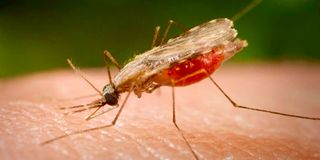Large number of malaria mosquitoes bite during the day, shows study

Anopheles mosquito
What you need to know:
- Normally, transmission of malarial parasites occurs via the bites of Anopheles mosquitoes, whose blood-feeding behaviour modulates the risk of infection.
- On the other hand, in many malaria endemic regions, Kenya being one of them, eradication strategies rely on reducing transmission by targeting nocturnal blood-feeding Anopheles with insecticidal nets.
A new study has shown that mass deployment of insecticidal bed nets and indoor residual spraying with insecticides may induce mosquitoes to blood-feed at places and at times when humans are not protected.
According to the study, around 20-30 per cent of mosquitoes that carry malaria-causing parasites bite during the day inside human dwellings.
The study conducted by a group of researchers and published in the scientific journal Proceedings of the National Academy of Sciences of the United States of America show that a proportion of mosquitoes that cause malaria may naturally feed when humans are not protected by nets, setting a ceiling to the efficacy of massive net-based interventions.
The research was conducted in Bangui, Central African Republic where malaria remains a major public health problem and the main cause of deaths among children below five years old despite numerous control programmes such as free distribution of long-lasting insecticidal nets to pregnant women and children.
In order to appreciate the potential of residual malaria transmission in this epidemiological context, researchers investigated the biting behaviour of the malaria vectors occurring in urban settings of Bangui. They found that 20 to 30 per cent of malaria vector biting occurred at full daytime indoors.
In total, 7,982 Anopheles mosquitoes were collected in Bangui between June 2016 and May 2017 at four sites within the city. Among the three species (A. gambiae, A. coluzzii, and A. funestus) considered to be competent malaria vectors in tropical Africa, the yearly average biting rate was 22.7 daily bites per person, while during the night period (from 1800 to 0600 hours), the yearly average biting rate was 17.9 bites per person per night-time.
These results suggest that current vector control interventions may not be enough to achieve sufficient reductions in malaria transmission in Bangui. Perhaps even more significant, these observations suggest that Anopheles mosquitoes may have the potential to achieve fundamental modifications in the temporal organisation and circadian control of their feeding behaviour, with major impacts on malaria control strategies in Africa.
Normally, transmission of malarial parasites occurs via the bites of Anopheles mosquitoes, whose blood-feeding behaviour modulates the risk of infection. On the other hand, in many malaria endemic regions, Kenya being one of them, eradication strategies rely on reducing transmission by targeting nocturnal blood-feeding Anopheles with insecticidal nets.
These changes, the researchers indicated, can set a ceiling to the efficacy of these control interventions, resulting in residual malaria transmission.



